I once watched a crew lose an entire day on-site.
They had the wrong dump truck which is too small for the load and not built for that kind of terrain. The driver kept spinning in the mud, frustrated, and the contractor kept checking his watch. Everyone was waiting and the costs kept rising.
That moment stuck with me because I’ve seen it happen more than once.
If you’re trying to figure out which dump truck fits your job, I get it. It’s not just about the truck. It’s about time, money, and getting the work done without delays.
In this article, you’ll get a breakdown of 9 common dump truck types. I’ll walk you through how they work, what they’re built for, and who uses them. By the end, you’ll have a clear picture of which one fits your worksite, your loads, and your goals.
Let’s start!
Quick Comparison
Before we jump into the full breakdown of each dump truck, here’s a quick glance to help you see the big picture. It’s a simple way to line them up and spot what matters most to you:
| Dump Truck Type | Load Capacity | Dump Method | Best Terrain | Ideal Use Cases | Main Advantage |
| Standard Dump Truck | 10–16 cu yds | Rear dump | Paved roads, tight sites | General construction, city road work | Easy to maneuver, reliable for daily use |
| Articulated Dump Truck (ADT) | 25–50 tons | Rear dump | Uneven, off-road, rough terrain | Mining, large construction, energy | Great traction and control off-road |
| Transfer Dump Truck | Up to 25 tons | Rear dump (multiple) | Paved roads, urban streets | Road projects, asphalt, general transport | Extra capacity with good maneuverability |
| Side Dump Truck | 23–30 tons | Side dump (left/right) | Paved or compacted ground | Roadwork, trenching, quick unloading | Safer dumping and fast unloading |
| Super Dump Truck | Up to 26 tons | Rear dump | Highways, city roads | Asphalt, paving, large-volume hauls | Carries more while staying road-legal |
| Semi-Trailer End Dump Truck | 24–30 tons | Rear dump | Highways, large job sites | Long-distance hauling, bulk delivery | High capacity, great for long hauls |
| Semi-Trailer Bottom Dump (Belly) | 23–28 tons | Bottom drop | Level roads, highways | Road base, gravel spreading | Spreads while moving, clean lines |
| Double/Triple Trailer Bottom Dumps | 40–50 tons | Bottom drop | Highways, rural roads | Agriculture, mining, large-scale delivery | Huge loads with fewer trips |
| Off-Highway Dump Truck (Rigid Hauler) | 60–300+ tons | Rear dump | Quarries, mines, rugged earthwork | Mining, dam projects, heavy-duty haul | Built for extreme loads and terrain |
Alright, now that you’ve seen the overview, let’s dive deeper into each type, starting with the one you’ve probably seen the most.
1. Standard Dump Truck
I used to think a dump truck was just a dump truck. Big, loud, and built to haul dirt. That’s it.
Then I spent a season working on a city road crew.
One week we had a standard dump truck on site. The next week, a different type. The difference? One helped us finish on time. The other slowed everything down.
That’s when I learned: the type of dump truck matters more than most people think.
So let’s start with the most familiar one.
A standard dump truck is the type you probably picture when you think of a dump truck.
It has one truck chassis, which means the body and cab are part of the same frame. The dump bed sits behind the cab and lifts using a hydraulic system. When it tilts up, gravity pushes the load out the back.
Simple and dependable.
You’ll often see these on construction sites, road projects, and even snow removal routes.
How It Works
Understanding how this truck operates can help you decide if it fits your needs.
Here’s how it works:
The driver positions the truck in reverse at the drop point. They engage the hydraulic lift, which raises the front of the dump body. As it tilts, material slides out the rear tailgate.
Because the body is directly attached to the chassis, these trucks are more stable on paved roads and easier to control in tighter spots.
Ever had to back a heavy truck into a narrow worksite? Then you know how much that matters.
Key Features
So what makes this truck different from others?
These are the features you’ll typically find:
- Single-frame design
- Rear hydraulic lift
- Manual or automatic tailgate
- Shorter wheelbase for tight turns
- Often 6 to 10 wheels depending on weight class
Some models also come with lift axles, which raise or lower depending on your load weight. That helps with wear and tear and road compliance.
Specs
Before you commit to a truck, you’ll want to understand what it can handle.
Most standard dump trucks have:
- Load capacity: about 10 to 16 cubic yards
- Gross weight: typically around 25,000 to 33,000 pounds
- Best terrain: paved roads, compacted gravel, city sites
- Dimensions: shorter than articulated or trailer models
- Turning radius: tighter than multi-axle setups
If you’re working in places with limited space, this kind of setup can really save you time.
Industry Applications
Now, where does this truck shine?
You’ll often find it used by:
- Construction crews hauling dirt, sand, and gravel
- Road repair teams working in cities and suburbs
- Landscaping contractors moving soil or stone
- Public works departments doing cleanup or snow removal
Does your job involve frequent trips on paved roads? Do you need something that can load fast and unload even faster? This type might fit you well.
Pros and Cons
Let’s wrap it up with the upsides and tradeoffs.
Pros:
- Easier to operate than articulated or semi models
- Good for jobs in tighter areas
- Simple hydraulic system
- Legal for road use in most areas
Cons:
- Can’t carry as much as trailer or off-road models
- Only rear unloading
- Not ideal for soft or uneven terrain
So, is this the dump truck you need?
If your work involves mid-size loads, frequent stops, or tight spaces, this truck might be the one that gets the job done without slowing you down.
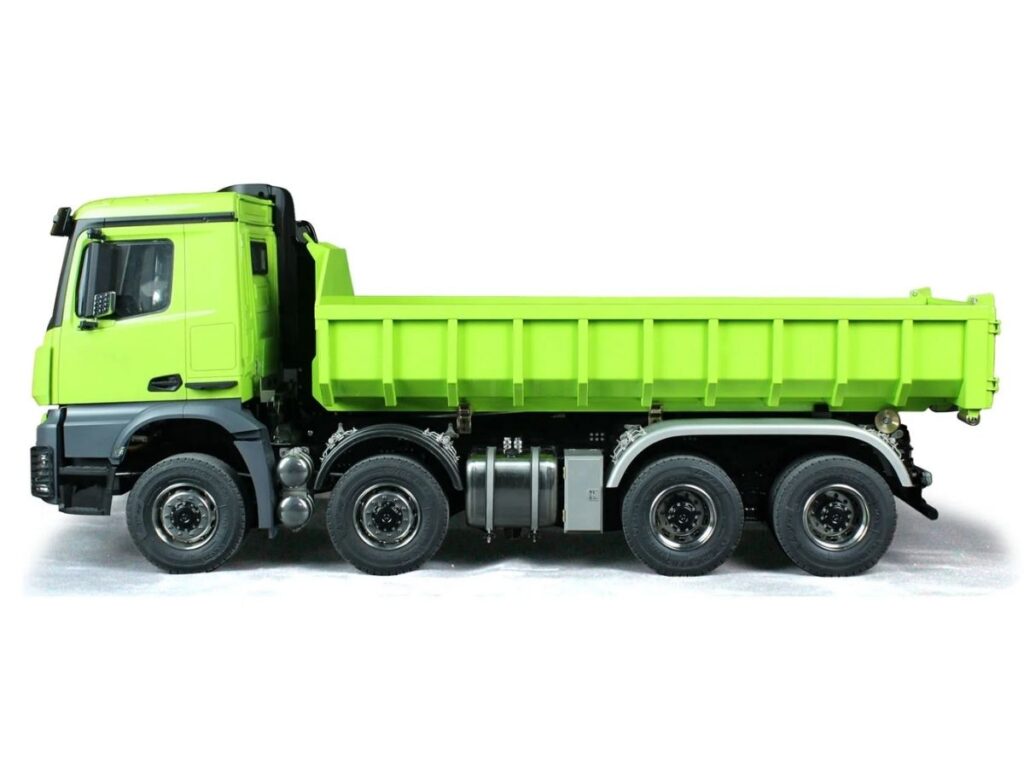
2. Articulated Dump Truck (ADT)
I remember standing on a muddy mining site, watching a truck glide over the rough terrain like it was nothing. No slipping and stalling. It just kept moving.
That was my first time seeing an articulated dump truck in action.
If you’ve ever struggled with soft soil, steep slopes, or uneven ground, this truck might be exactly what you need.
An articulated dump truck, or ADT, is made of two parts:
- Cab
- Dump body
They’re connected by a pivot joint, which allows the front and back to move independently.
That’s what makes it different and that’s what gives it power on rough terrain.
The steering is also different.
Instead of just turning the front wheels, the whole cab turns at the joint. This lets the truck handle sharp turns and tight paths without tipping or losing balance.
How It Works
Let’s talk about the work side of things.
The ADT is built for off-road use. It drives like a heavy-duty 4×4 but hauls like a dump truck. You’ll often find it on big construction sites, mines, and quarries.
Because of the jointed design, it can go places other trucks can’t. It can twist and turn through hills, mud, and loose gravel and it doesn’t just survive in tough conditions, it performs well in them.
Key Features
Here’s what you can expect:
- Articulated frame with a pivot point
- All-wheel drive
- Large tires for off-road grip
- Rear dump body with hydraulic lift
- High ground clearance
Specs
Typical ADTs have:
- Load capacity: 25 to 50 tons
- Best terrain: soft, uneven, or sloped ground
- Turning radius: tighter than rigid-frame trucks
- Speed: slower than highway trucks but strong in rough areas
Industry Applications
You’ll often see ADTs used in:
- Mining and quarry operations
- Large-scale construction projects
- Oil and gas sites
- Remote forestry jobs
Pros and Cons
Pros:
- Great traction on soft or steep ground
- Can haul large loads in tough conditions
- Easier to control than rigid trucks on uneven sites
Cons:
- Not meant for highway use
- Higher cost and maintenance
- Needs trained drivers
So, do you need a truck that can handle mud, rocks, and hills without getting stuck?
If you work off-road and move heavy loads, an ADT could be a smart choice.
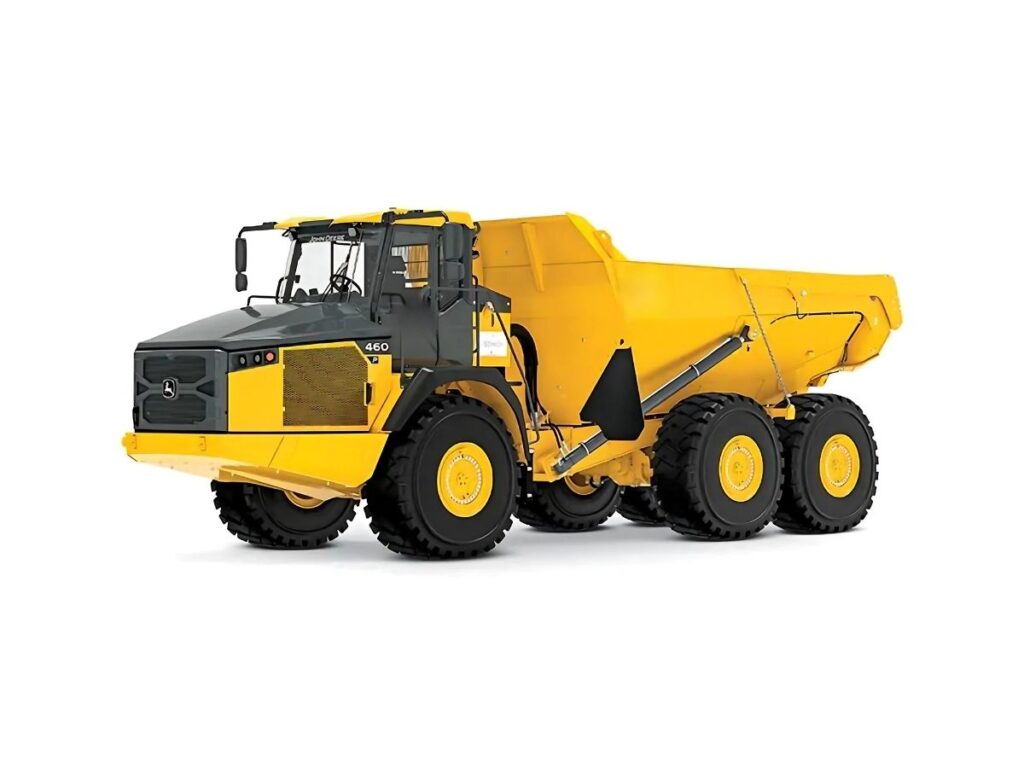
3. Transfer Dump Truck
A transfer dump truck is a standard dump truck with a second, separate container called a “trailer” that gets pulled behind.
But here’s the twist, the extra container isn’t just for towing. It’s designed to slide into the main truck body using a special system. Once it’s empty, the driver pulls the trailer back in and keeps going.
It’s a clever setup. You get more hauling space without using a full-sized trailer truck.
How It Works
The driver starts with the full load. When it’s time to dump, the main truck unloads first.
Then, using a motorized rail system or chains, the second container rolls forward into the main bed. The driver dumps that load next.
This setup lets you carry more material without needing multiple trips or an extra driver.
Key Features
These trucks are built for performance in tight spaces. Common features include:
- Standard dump truck body
- Separate trailer with a second load
- Rail or chain system to move the trailer
- Dual hydraulic lifts
- Designed for road use
Specs
Here’s what to expect:
- Load capacity: up to 25 tons total
- Best terrain: paved roads, urban sites, highways
- Turning radius: tighter than semi trucks
- Speed: street legal and highway ready
Industry Applications
You’ll usually find transfer dump trucks working in:
- Road construction and repair
- Asphalt delivery
- Urban material hauling
- Large landscaping jobs
Pros and Cons
Pros:
- Higher capacity than standard dump trucks
- Great for tight streets or city work
- Doesn’t need a second driver or extra truck
Cons:
- More moving parts mean more maintenance
- Not made for off-road use
- Setup takes a bit of time to learn
So, do you need to haul more without going full semi? If you’re working on roads or in cities, this might be the truck that fits your job best.
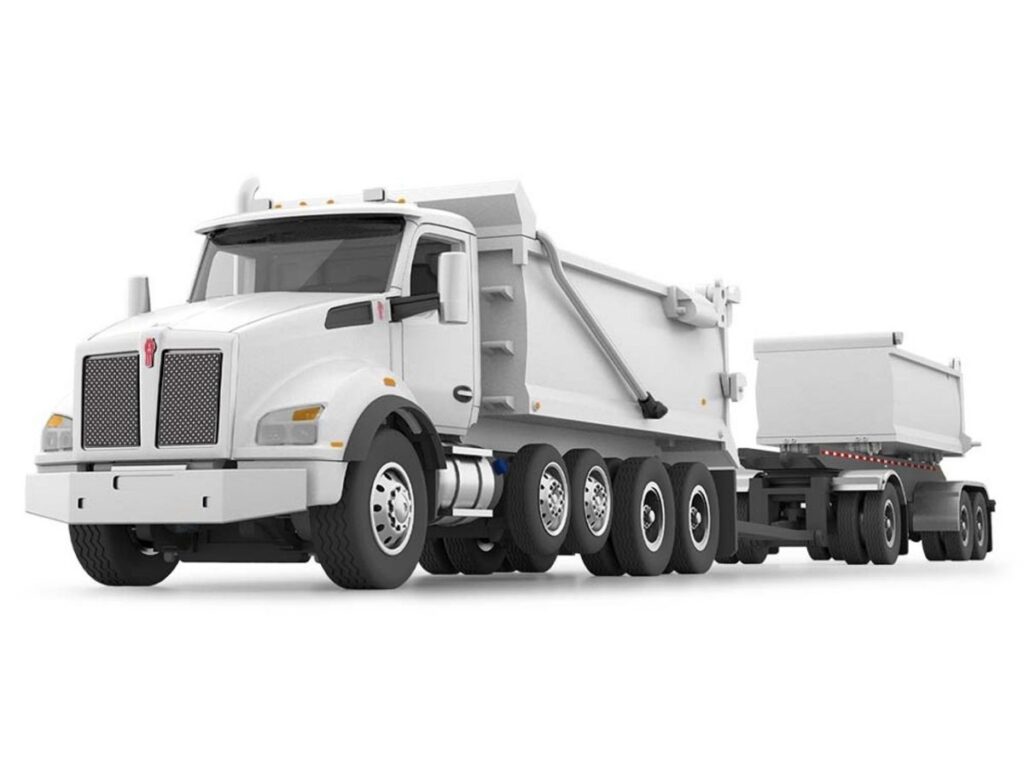
4. Side Dump Truck
A side dump truck has a trailer or dump body that tilts to one side instead of lifting from the front. The body is often rounded or shaped like a trough. Hydraulic cylinders lift the body, and the material slides out to the left or right.
It’s a simple design with a big advantage: stability.
Instead of raising the bed high in the air like a rear dump, this one tilts low and to the side. Less lift means less chance of tipping over.
How It Works
Now, let’s talk about how this truck actually works on the job.
The driver pulls alongside the dump area. No need to reverse in. No need to line up just right.
They engage the hydraulics. The body tilts. Material slides off quickly and cleanly.
This can save time and if you’ve ever been on a job with little room to move, you know how valuable that can be.
Key Features
Side dump trucks are known for:
- U-shaped or rounded dump body
- Side-tilting hydraulic system
- Quick unloading
- Greater stability during dumps
- Some models dump to either side
Specs
Here’s what you can expect from most models:
- Load capacity: around 23 to 30 tons
- Best terrain: paved roads or solid ground
- Dump direction: left, right, or both
- Height: lower center of gravity than rear dump trucks
Industry Applications
These trucks are often used in:
- Road construction
- Utility and trenching jobs
- Railroad work
- Large site prep where speed matters
Pros and Cons
Pros:
- Faster dumping compared to other types
- Less chance of tipping
- Easier to use in tight or sloped areas
Cons:
- Not ideal for sticky or oversized materials
- Needs side space to unload
- Slightly more moving parts to maintain
If your job needs stability, speed, and flexibility, the side dump might be worth a closer look.
And if you’re looking for a trailer that’s built for your exact needs, not just pulled off a shelf, Rhinotrail is here to help. We offer customized semi-trailers, including dump, flatbed, container, low-bed, and more. Let’s build something that actually fits your work.
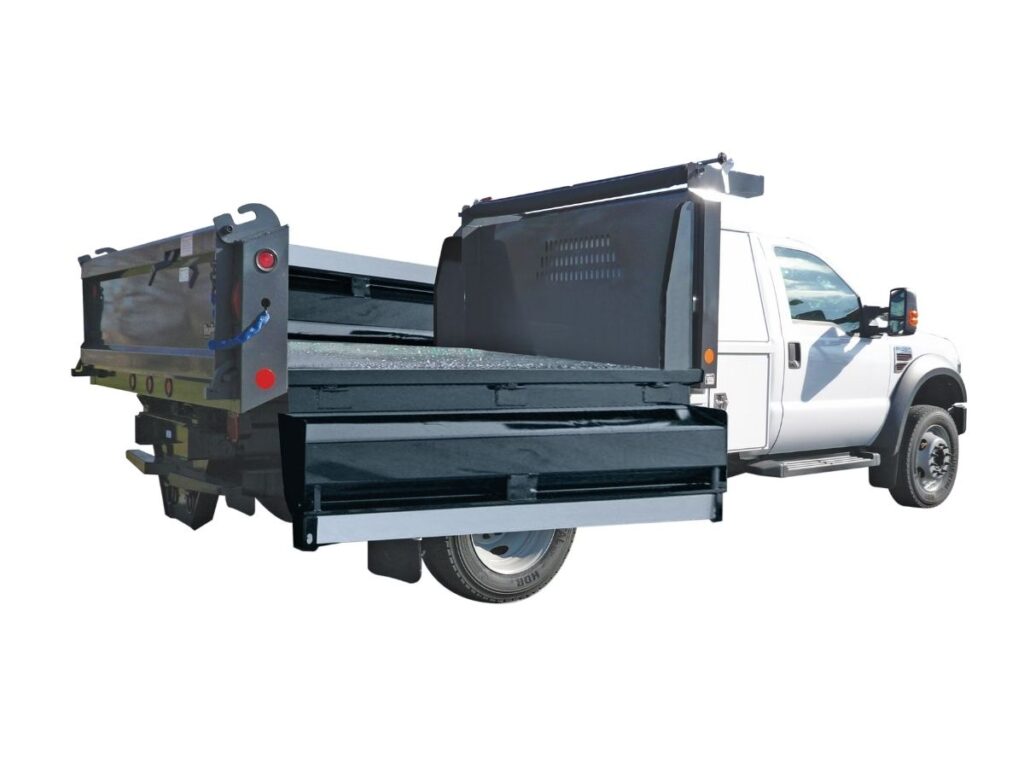
5. Super Dump Truck
A while back, I was helping out on a highway paving job. Trucks were lined up, waiting to unload. One of them caught my eye.
It looked like a regular dump truck at first. But it had an extra axle stretched out behind it. Then it dumped a massive load more than any other truck on site.
That was the day I learned what a super dump truck could really do.
Let’s break it down.
A super dump truck is a type of standard dump truck. What makes it different is the extra axle called a trailing axle that extends behind the rear wheels.
This axle can be lowered when the truck is full and lifted when it’s empty. By spreading the weight across more wheels, the truck can carry a much heavier load while staying within legal weight limits for road use.
It’s like getting the benefit of a larger trailer without having to drive one.
How It Works
When fully loaded, the driver lowers the trailing axle. This supports the extra weight and keeps the truck balanced.
As the truck unloads, the axle lifts again. That reduces wear on the tires and saves fuel during empty runs.
It’s a smart system that gives you more power without losing flexibility.
Key Features
Common features include:
- Standard dump body with rear hydraulic lift
- Liftable trailing axle
- Compact design compared to full trailer setups
- Legal weight compliance for roads and highways
- Operated by a single driver
Specs
Here’s what most super dump trucks offer:
- Load capacity: up to 26 tons
- Best terrain: paved roads, job sites with good access
- Dump direction: rear unload
- Axle setup: usually 4 to 7 axles depending on configuration
Industry Applications
You’ll see these trucks used in:
- Asphalt and road paving
- Construction supply delivery
- High-volume hauling jobs
- Sites where fewer trips save time and money
Pros and Cons
Pros:
- Carries bigger loads without breaking weight limits
- Reduces trips and boosts efficiency
- Road legal in most regions
Cons:
- More expensive than basic dump trucks
- More parts to check and maintain
- Not ideal for off-road or tight spaces
If your work calls for volume and speed, and you’re working mostly on the road, a super dump can be a smart investment.
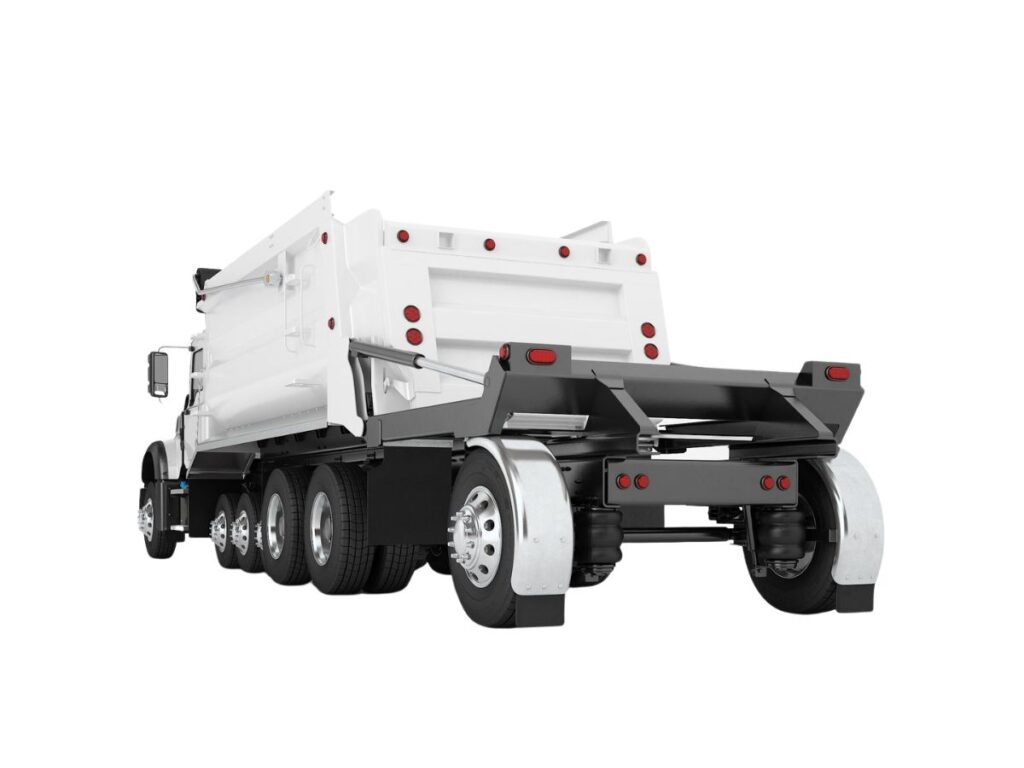
6. Semi-Trailer End Dump Truck
I once worked at a materials supply yard. Every morning, our biggest truck would head out early.
It didn’t look like a typical dump truck. It was longer, stretched out, and pulled by a semi tractor. But it hauled more than any other vehicle in the yard.
That was our semi end dump truck. And it was built for long-distance jobs.
A semi-trailer end dump truck combines a semi truck and a dump trailer. The trailer has a long bed with a hydraulic lift that raises from the front, so the material slides out the back.
It works like a traditional dump truck, but with one big advantage: more capacity.
Because it’s a trailer, the load is spread out across a longer surface. That means it can carry more without overloading the axles.
How It Works
The truck backs into position just like a regular dump. The driver lifts the front of the trailer using the hydraulic system, then the material flows out the rear gate.
This type of truck is common on jobs that involve long hauls or repeated delivery over highways.
Have you ever needed to move bulk materials far from the source? Then this setup might make sense for you.
Key Features
Most setups include:
- A semi truck with a connected dump trailer
- Hydraulic front lift system
- Rear tailgate for unloading
- Long trailer for high capacity
- Built for long-distance, road-based work
Specs
You’ll often see:
- Load capacity: 24 to 30 tons
- Best terrain: paved roads, highways, open job sites
- Trailer length: longer than standard dump trucks
- Dump method: rear unload
Industry Applications
These trucks are widely used in:
- Bulk material transport
- Quarry to plant hauling
- Road and infrastructure projects
- Agricultural supply deliveries
Pros and Cons
Pros:
- High-volume capacity
- Great for highway hauling
- Flexible trailer and cab setup
Cons:
- Needs space to dump safely
- Less stable on uneven ground when raised
- Not suitable for tight or off-road sites
If you value capacity and highway speed over maneuverability, this could be your next hauler.
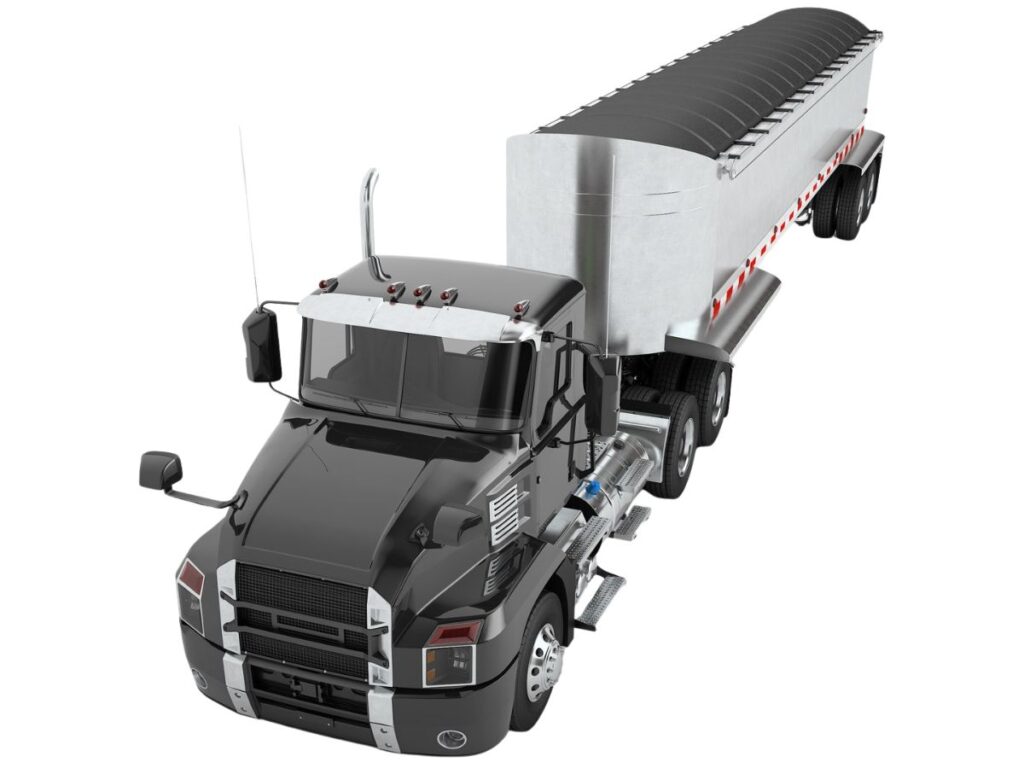
7. Semi-Trailer Bottom Dump Truck (Belly Dump)
A semi-trailer bottom dump truck, also known as a belly dump, is a semi-truck pulling a trailer with a hopper-style bed. Instead of dumping from the rear or side, it releases material through doors in the bottom of the trailer.
The bed looks like a funnel. It opens downward, and material falls in a straight line onto the road or job site.
This setup gives you more control over where the load lands, which is a big help on long, narrow paths or roadwork.
How It Works
Here’s how it functions on the job.
The driver positions the truck where the material needs to go. They slowly drive forward while opening the belly doors.
The load spills out in a line rather than a pile. This helps save time and labor, especially if the material needs to be spread evenly.
Key Features
Most belly dumps include:
- Hopper-style dump body
- Bottom gate or door system
- Pneumatic or hydraulic control
- Semi-truck and trailer configuration
- Designed for on-road use
Specs
Typical specs look like this:
- Load capacity: around 23 to 28 tons
- Dump type: center bottom release
- Best terrain: paved or level road surfaces
- Control: cab-operated gate release
Industry Applications
Belly dumps are used for:
- Road base laying
- Gravel and sand spreading
- Highway maintenance
- Agricultural feed delivery
Pros and Cons
Pros:
- Spreads material while moving
- Safer unloading compared to high lifts
- Quick and efficient drops
Cons:
- Needs level ground for best results
- Not ideal for rough terrain
- Less precise if you’re not careful with speed
If your work calls for even coverage over distance, the belly dump is worth serious consideration.
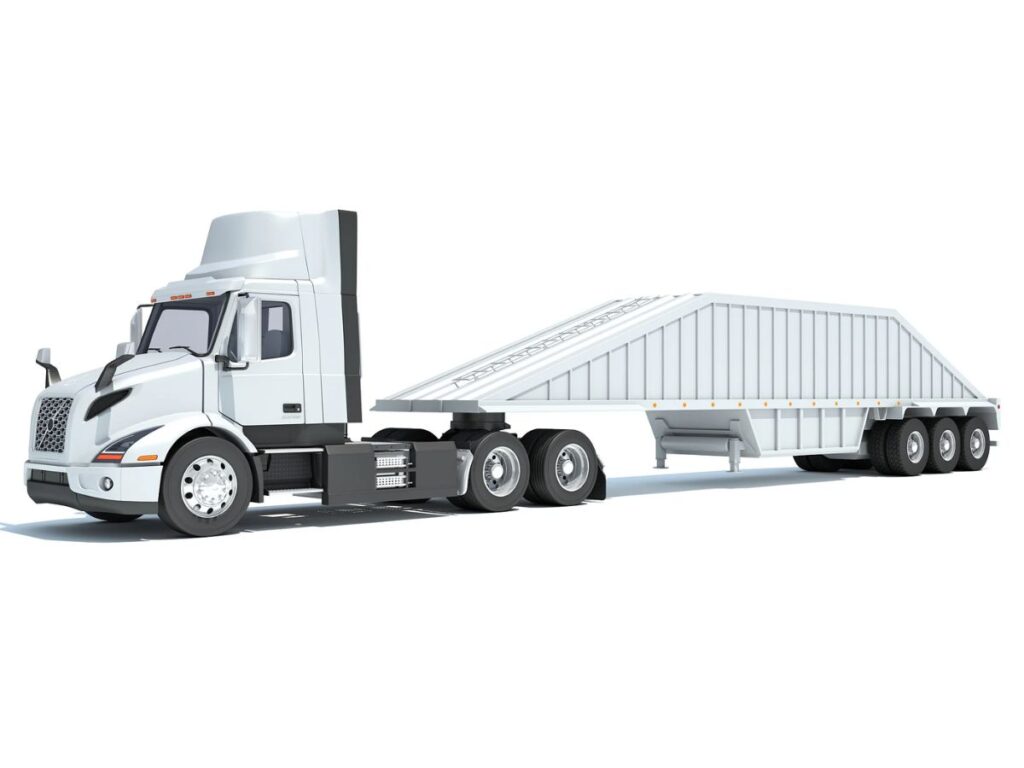
8. Double and Triple Trailer Bottom Dumps
A semi-trailer bottom dump truck, often called a belly dump, is built for continuous unloading. Instead of dumping out the back or side, this truck releases material through doors in the bottom of the trailer.
The bed is shaped like a funnel. When the gates open, gravity does the work.
This setup is all about control and speed especially when you need to spread material over long distances.
How It Works
The driver starts moving, then opens the bottom gates. As the truck drives, material falls in a steady line onto the surface below.
This is ideal for laying road bases, gravel, or sand.
The drop is smooth, controlled, and doesn’t need extra labor to spread it out.
Ever been stuck spreading dump piles with a rake? If so, you’ll appreciate how much time this saves.
Key Features
Most belly dumps come with:
- Hopper-style dump bed
- Bottom gate unloading system
- Semi-truck and trailer combo
- Pneumatic or hydraulic controls
- Designed for paved roads and highways
Specs
You can expect:
- Load capacity: around 23 to 28 tons
- Dump type: center bottom release
- Best terrain: paved or level roadways
- Operation: remote gate control from inside the cab
Industry Applications
These trucks are used for:
- Road building and repair
- Gravel and sand delivery
- Site prep work
- Agriculture and feed supply
Pros and Cons
Pros:
- Massive hauling capacity
- Efficient for long routes
- Spreads materials in motion
Cons:
- Needs skilled drivers
- Hard to maneuver in tight spaces
- Not built for off-road or soft terrain
If your work involves volume, distance, and consistent spreading, a double or triple bottom dump could help you get it done faster—with fewer runs.
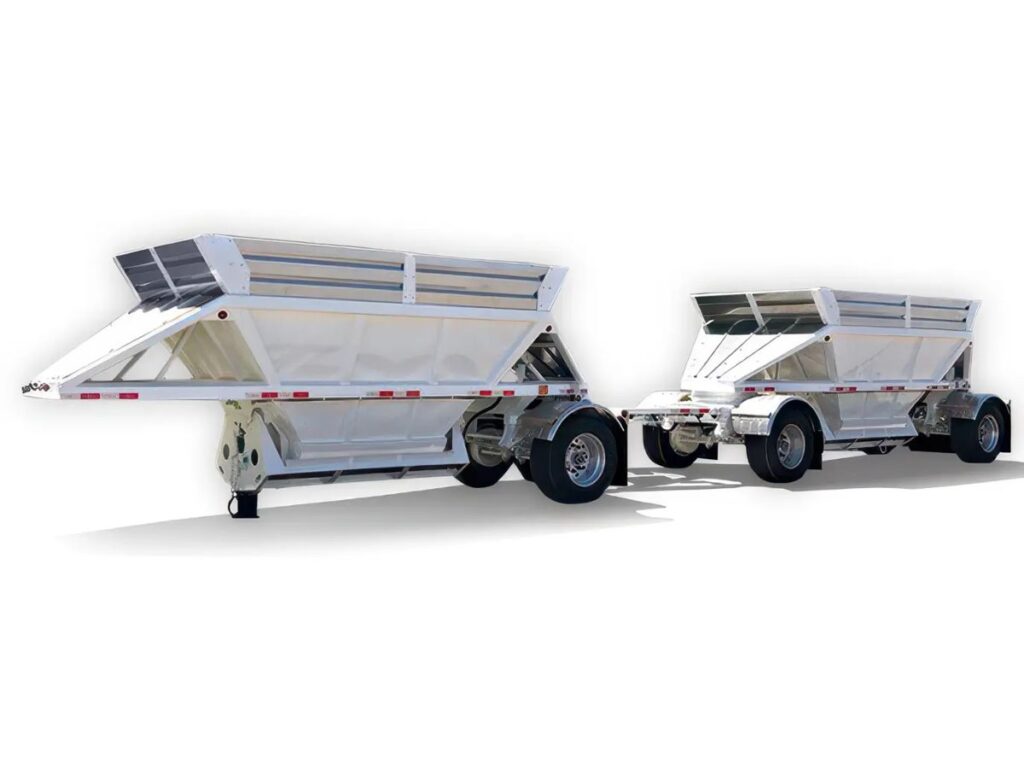
9. Off-Highway Dump Truck (Rigid Hauler)
A few summers ago, I toured a surface mine with a friend who worked in operations. As we stood near the pit, I heard a low rumble behind us then I saw a massive off-highway dump truck rolled up, towering over everything nearby. The tires alone were taller than most people I know.
It wasn’t just a truck. It felt like a moving mountain.
An off-highway dump truck, also called a rigid hauler, is built for one purpose: moving massive loads over rough terrain.
These trucks aren’t street-legal. You won’t see them on highways or city roads. They’re made for places like mining sites, quarries, and large construction zones.
Unlike articulated dump trucks, rigid haulers have a fixed frame. The cab and dump body sit on one solid chassis, which gives them strength and stability under heavy loads.
How It Works
The operator drives the truck into a loading zone where huge excavators or loaders fill the bed with rock, dirt, or ore.
Once full, the truck hauls the material across uneven terrain to a dumping point. The hydraulic lift raises the front of the bed, and the load slides out the back.
If you’ve got extreme terrain and heavy loads, this is the kind of truck you need.
Key Features
Most rigid haulers come with:
- One-piece frame (non-articulated)
- Extra-large dump body
- Powerful diesel engine
- High-capacity hydraulic system
- Heavy-duty suspension and massive tires
Specs
Typical numbers include:
- Load capacity: 60 to over 300 tons
- Best terrain: mines, quarries, large earthmoving sites
- Dump method: rear unload
- Speed: slow but powerful
Industry Applications
You’ll find rigid haulers used in:
- Open-pit mining
- Quarry operations
- Major earthwork or dam construction
- Heavy-duty bulk material movement
Pros and Cons
Pros:
- Handles extreme weight and terrain
- Built for tough, long-term use
- Simple frame design adds durability
Cons:
- Not legal on roads
- Expensive to purchase and maintain
- Requires wide spaces to operate
If you’re working in rough, high-volume environments, an off-highway dump truck delivers the power and capacity standard trucks can’t match.
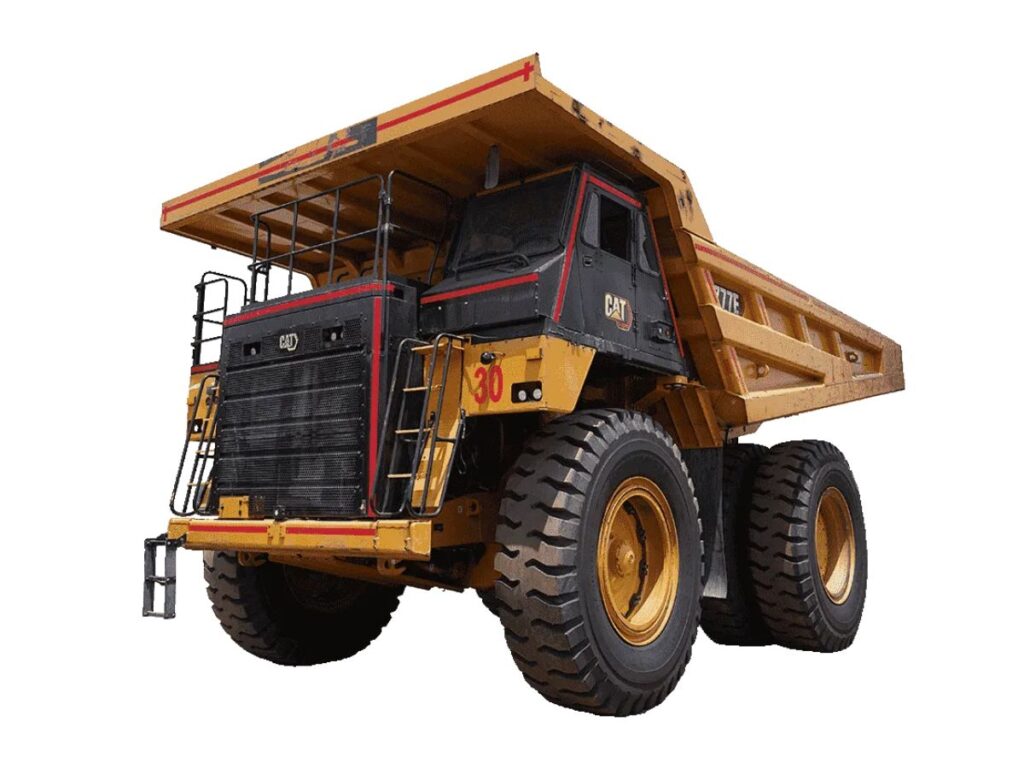
Conclusion
You made it through all 9 dump truck types.
You now know which ones work best in cities, on highways, or deep in the mines and you’ve got a clear picture of how each one operates.
So, what’s next?
Are you hauling gravel, clearing debris, or building roads?
No matter the job, your next step is clear, to choose the truck that fits your needs.
Need help finding the right one? Contact us today.


